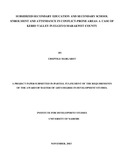Subsidized secondary education and secondary school enrolment and attendance in conflict-prone areas: A case of kerio valley in Elgeyo-Marakwet county

View/
Date
2013-11Author
Cheptile, Margaret
Type
ThesisLanguage
enMetadata
Show full item recordAbstract
Like in many African countries, access to secondary education in Kenya has been a challenge
primarily due to cost of schooling. In response, the Kenyan Government introduced subsidized
secondary education in 2008 to ensure that all qualified children access secondary education
regardless of their socio-economic backgrounds. While national statistics estimate that
secondary school Gross and Net Enrolment Rates have increased since secondary education was
subsidized, they cannot be relied upon since they generalize and tend to obscure school
participation inequalities across the regional divide. Specifically, conflict-prone areas generally
experience low access to secondary schooling owing to disrupted livelihoods and financial
obstacles accompanying conflicts. However, since the provision of secondary school subsidy in
2008 no empirical study, to the best of my knowledge, has been conducted to investigate whether
access to secondary school in conflict-prone areas has been enhanced.
The overall research objective of this study is to determine the effect of subsidized secondary
education on secondary school enrolment and attendance in the conflict-prone area of Kerio
Valley in Elgeyo-Marakwet County. In order to achieve this objective, a survey of sixty
households with children of secondary school age (14-21 years) was conducted through the use
of snowball sampling technique. Also, secondary school Head Teachers and Marakwet District
Education Officers were purposively selected as key informants. Data was collected through face
to face interviews from all the respondents using questionnaires and interview guides. Key
informants’ data were thematically analyzed using Microsoft Word Tables while data from
households were coded and entered into SPSS for analysis.
The study found that household characteristics such as household size, income, parents’
education, and number of children of secondary school age influenced secondary school
enrolment. It also found that secondary school enrolment in the households was fairly low and
most of those enrolled failed to attend school regularly mainly due to lack of school fees. It was
further observed that the Pokot-Marakwet conflict contributed partly to households’ inability to
meet school fees. Despite provision of subsidized secondary education, school fees for both Day
and Boarding secondary schools were still high and not far apart; about two times the amount of
subsidy provided by the Government. Overall, however, the study established that secondary
school enrolment and attendance levels in most of the sampled households have gotten better
since secondary education was subsidized in 2008.
The study concludes that household characteristics determine whether or not a child goes to
school in the sampled households. Secondary school participation in the households is low with
the main reason being lack of school fees. The study also concludes that the inability to meet
secondary school fees is partly linked to the effects of Pokot-Marakwet conflict such as disrupted
livelihoods and aggravated poverty. The study views that the subsidy provided is inadequate in
comparison to the high cost of other school items met by the households. Nevertheless, the
subsidy is seen to have a potential to improve access to secondary education in the sampled
households. To improve the effectiveness of subsidized secondary education in Kerio Valley, the
study recommends the Government and other key stakeholders to look for ways of increasing the
annual capitation grant, ensure timely disbursement of funds, and combat Pokot-Marakwet
conflict.
Citation
Master Of Arts Degree In Development Studies , Institute For Development Studies, University Of Nairobi, 2013Publisher
University of Nairobi, Institute for development studies,
